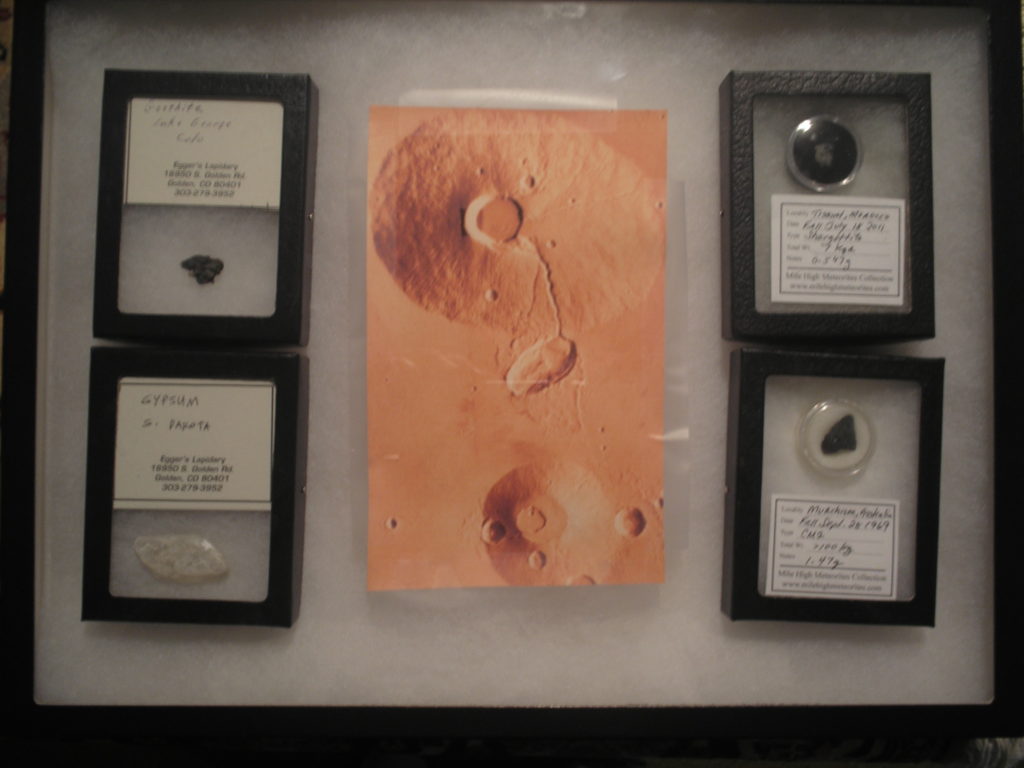The environmental requirements for life are:
- A source of molecules from which to build its own cellular structures and for reproduction
- A source of energy to maintain biological order and to fuel the many chemical reactions that occur in life
- A liquid medium – most likely liquid water – for transporting the molecules of life
Source: Beyond UFOs, by Jeffrey Benner, 2008, Princeton University Press
Life on Mars in a Box
The Life on Mars box contains illustrations of research results that show these requirements are met on the planet Mars:
- The picture of the volcanoes on Mars shows an energy source (as well as cosmic rays, UV rays, etc. coming from space)
- The dark mineral (Goethite) and the light mineral (Gypsum) show hydrothermal groundwater circulation during the early history of Mars (Ehlmann et al, Nature, 2011)
- The piece of the Murchison meteorite, which contains non-biological carbon in the form of amino acids, shows the availability of life-building molecules (Kvenvolden et al, Nature, 1970)
- The piece of the Shergottite meteorite from Mars, which contains non-biological carbon created by volcanic action during the early history of Mars, shows a second source of life-building molecules (Steele et al, Science, 2012)
The key to this puzzle is whether all these ingredients for life came together in the right proportions at the right time (conversation with Pamela Conrad, NASA astrobiologist and assistant principal investigator of the SAM instrument on the Mars Science Laboratory, which landed on Mars in August, 2012)
Origin of Life Meteorite and Mineral Exhibit
The mini version of the Meteorite and Mineral Exhibit was created for educating people about the Origin of Life.
The piece of the Murchison meteorite ( middle right ) contains organic molecules
The crust of a rocky planet contains enough water to create an ocean
The sources of energy and location for the start of life have changed over 50 years
In the 70’s it was thought to be clay ( montmorillonite- top left )
In the 80’s it was thought to be black smoker vents on the ocean floor ( pyrite- middle left )
In the 2000’s it was thought to be white smoker vents on the ocean floor (Serpentinization Minerals Olivine Serpentine Magnetite Brucite bottom row )
In 2013 it was thought to be Mars because it had enough dry land to create boron to stabilize ribose in RNA ( A meteorite like Tissint- middle left bringing life to Earth )
In 2015 it was thought to be surface hot springs ( sinter- top left in pink )
In 2016 it was thought to be volcanic island splash pools ( opaline silica- middle right)
In 2017 it was thought to be sediment at the bottom of the ocean in silica gel which precipitates into chert ( upper right )
In future years there will be new sources of energy and locations for the start of life
from new theories.

Origin of Life Meteorite and Mineral Exhibit
The Origin of Life Meteorite and Mineral Exhibit has been approved by both NASA and ESA and was invited to be shown at both final landing site meetings for both rovers and verified again by the National Academy of Sciences.
Exhibits prepared by Robert Bruner
Denver Museum of Nature and Science volunteer
bobbruner40 -at- hotmail.com
Read more about Bob and his story here: Bob Bruner and the Search for Life on Mars

